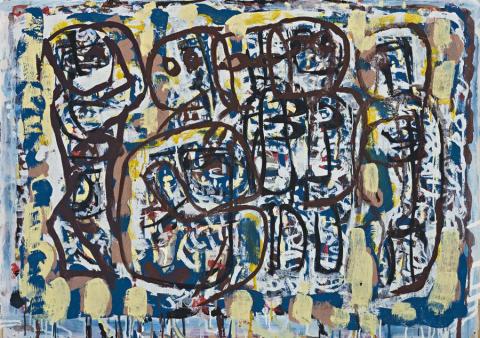SUMMER, 1964
Ian Fairweather
synthetic polymer paint and gouache on cardboard on hardboard
71.5 x 101.5 cm
signed lower right: Ian Fairweather
Macquarie Galleries, Sydney
Hazel Hughes, Sydney
Collection of the Art Gallery of New South Wales, Sydney, gift of the above in memory of Norman Schureck 1965 (label attached verso)
Ian Fairweather: the Drunken Buddha and other recent works, Macquarie Galleries, Sydney, 12—24 May 1965, cat. 20
Bail, M., Fairweather, Murdoch Books, Sydney, revised edition 2009, pp. 210, 259, cat. 206, p. 208, pl. 180 (illus.)
In 1964 Ian Fairweather painted four pictures devoted to the seasons, each simply named after the time of the year it represented. For Summer he chose the horizontal format, Summer and Winter being larger and similar in size. Whether this had any significance is hard to say other than that one season is rich in its abundance of sunlight and fruits of the earth. The grip of winter always seems longer than it is. The seasons have inspired artists from many civilizations over countless years. Some of the finest Chinese and Japanese art is devoted to their individual beauties and characteristics, while in the West they have inspired our finest music, literature, and art. Vivaldi's Le quattro stagioni (The Four Seasons) is his most popular work; and Haydn's beautiful oratorio The Seasons is full of joy. Shakespeare gave us The Winter's Tale and much else about the seasons; and Keats's great ode To Autumn evokes its 'mists and mellow fruitfulness'. Pieter Bruegel the Elder's The Seasons are numbered among the masterpieces of European art, while the French Impressionists delighted in capturing seasonal changes in light and colour. Australia is not without its memorable paintings, reaching from the Wandjina rock paintings which glow during the wet season, through John Glover's My Harvest Home, S. T. Gill's The Australian Seasons, Streeton's lyrical springtimes and Frederick McCubbin's autumnal nocturnes, to memorable works by Fred Williams and John Olsen.
Painted on Bribie Island, the relaxed line in Fairweather's Summer captures the lassitude of the season, the calligraphy suggesting a time when 'the livin' is easy'. Bright yellows of sunlight surround figures which sport in a field of blues and whites. Murray Bail, in his monograph on Fairweather, describes the figures as having 'stripped off and are on the beach, knee-deep in the shallows to cool off.'1 While the configurations and colours lend themselves to such an interpretation, Summer reaches beyond the mere pleasures of the beach. Shown in his 1965 exhibition at the Macquarie Galleries, the exhibition featured twelve paintings illustrating Fairweather's translation of the old Chinese tale The Drunken Buddha. The exhibition included Summer and other recent work 'infused with the living spirit of Chinese art.'2 Describing Fairweather as 'a very rare artist indeed', James Gleeson as art critic explained that 'His lines do not passively define something the eye has already seen in nature; they embody the very nature of the thing seen.' So it is with Summer in so much as it can be encompassed within gouache on cardboard.
1. Bail, M., Fairweather, Murdoch Books, Sydney, 2009, p. 210
2. Gleeson, J., 'Fusing art forms', Sun-Herald, Sydney, 16 May 1965, p. 82
DAVID THOMAS
